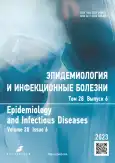The role of genetic variants of the SARS-CoV-2 virus in forming of intra-annual increases in the incidence of COVID-19 in Perm Region
- Authors: Sergevnin V.I.1, Isaeva I.S.2, Rozhkova M.V.3, Markovich N.I.4
-
Affiliations:
- Perm State Medical University named after Academician E.A. Wagner
- Center of Hygiene and Epidemiology in Perm Region
- Perm Regional Center for Control and Prevention of AIDS and Infectious Diseases
- Perm Center for Immunization
- Issue: Vol 28, No 6 (2023)
- Pages: 343-352
- Section: Original study articles
- URL: https://journals.rcsi.science/1560-9529/article/view/251343
- DOI: https://doi.org/10.17816/EID607427
- ID: 251343
Cite item
Abstract
BACKGROUND: The causes of intra-annual increases in COVID-19 incidence remain insufficiently studied.
AIM: This study aimed to investigate the role of genetic variants of SARS-CoV-2 in intra-annual increases of COVID-19 incidence in the Perm region.
MATERIALS AND METHODS: The monthly dynamics of COVID-19 morbidity and mortality of the population of the Perm region from March 2020 to December 31, 2022 was assessed. The analysis of the monthly frequency of isolation of patients with different genetic variants of SARS-CoV-2 was conducted based on the study results of 2,592 samples from patients in the Perm region performed by specialized laboratories of research institutes in Russia between March 2021 and December 2022. The assessment of the incidence of IgG antibodies to coronavirus among the population was provided according to blood serum studies of 14,006 people.
RESULTS: In 2020–2022, 4 rises in the incidence of COVID-19 were detected in the Perm region against the background of the emergence of new genetic variants of the pathogen, mainly Alpha, Delta, and Omicron. Increases in COVID-19 incidence and a change in the genetic structure of the pathogen were observed despite an increase in the proportion of people with SARS-CoV-2 IgG in the blood serum. Against the background of the third and fourth increases in morbidity, when the Omicron genotype acquired the leading etiological significance, the infection fatality rate decreased significantly.
CONCLUSIONS: Intra-annual increases in COVID-19 incidence are largely associated with changes in the genetic structure of the pathogen and are observed despite an increase in the number of people among the population with IgG to SARS-CoV-2 in the blood serum.
Full Text
##article.viewOnOriginalSite##About the authors
Victor I. Sergevnin
Perm State Medical University named after Academician E.A. Wagner
Email: viktor-sergevnin@mail.ru
ORCID iD: 0000-0002-2729-2248
SPIN-code: 4705-0671
MD, Dr. Sci. (Med.), Professor
Russian Federation, PermIrina S. Isaeva
Center of Hygiene and Epidemiology in Perm Region
Email: isaeva27iris@gmail.com
ORCID iD: 0009-0000-2629-6995
Russian Federation, Perm
Marina V. Rozhkova
Perm Regional Center for Control and Prevention of AIDS and Infectious Diseases
Author for correspondence.
Email: RozhkovaMary@yandex.ru
ORCID iD: 0000-0002-1113-1001
Russian Federation, Perm
Nina I. Markovich
Perm Center for Immunization
Email: barhat120140@mail.ru
ORCID iD: 0000-0002-5596-4611
SPIN-code: 1313-1740
MD, Dr. Sci. (Med.)
Russian Federation, PermReferences
- Trotsenko OE, Korita TV, Kotova VO, et al. Еpidemiological and molecular-genetic peculiarities of COVID-19 infection during fifth wave of pandemic in constituent entities of the Far Eastern Federal District of the Russian Federation. The Far Eastern Journal of Infectious Pathology. 2022;(42):54–69. (In Russ).
- Lin G, Hamilton А, Gatalo О, et al. Investigating the effects of absolute humidity and movement on COVID-19 seasonality in the United States. Sci Rep. 2022;(12):16729. doi: 10.1038/s41598-022-19898-8
- Akimkin VG, Popova AY, Ploskireva AA, et al. COVID-19: the evolution of the pandemic in Russia. Report I: manifestations of the COVID-19 epidemic process. Journal of microbiology, epidemiology and immunobiology. 2022;99(3):269–286. (In Russ). doi: 10.36233/0372-9311-276
- Akimkin VG, Popova AY, Khafizov KF, et al. COVID-19: evolution of the pandemic in Russia. Report II: dynamics of the circulation of SARS-CoV-2 genetic variants. Journal of microbiology, epidemiology and immunobiology. 2022;99(4):381–396. (In Russ). doi: 10.36233/0372-9311-295
- Borisova NI, Kotov IA, Kolesnikov AA, et al. Monitoring the spread of the SARS-CoV-2 (Coronaviridae: Coronavirinae: Betacoronavirus; Sarbecovirus) variants in the Moscow region using targeted high-throughput sequencing. Problems of Virology. 2021;66(4):269–278. (In Russ). doi: 10.36233/0507-4088-72
- Md Iderus NH, Lakha Singh SS, Mohd Ghazali S. et al. Correlation between population density and COVID-19 cases during the third wave in Malaysia: Effect of the Delta variant. Int J Environ Res Public Health. 2022;19(12):7439. doi: 10.3390/ijerph19127439
- Araf Y, Akter F, Tang Y, et al. Omicron variant of SARS-CoV-2: Genomics, transmissibility, and responses to current COVID-19 vaccines. J Med Virol. 2022:94(5):1825–1832. doi: 10.1002/jmv.27588
- Khan MS, Kim E, Huang S, Kenniston TW, Gambotto A. Trivalent SARS-CoV-2 S1 subunit protein vaccination induces broad humoral responses in BALB/c Mice. Vaccines. 2023;11(2):314. doi: 10.3390/vaccines11020314
- Zabidi NZ, Liew HL, Farouk IA, et al. Evolution of SARS-CoV-2 variants: Implications on immune escape, vaccination, therapeutic and diagnostic strategies. Viruses. 2023;15(4):944. doi: 10.3390/v15040944
- Wang Q, Iketani S, Li Z, et al. Alarming antibody evasion properties of rising SARS-CoV-2 BQ and XBB subvariants. Cell. 2023;186(2): 279–286. doi: 10.1016/j.cell.2022.12.018
- Kumar S, Karuppanan K, Subramaniam G. Omicron (BA.1) and sub-variants (BA.1.1, BA.2, and BA.3) of SARS-CoV-2 spike infectivity and pathogenicity: A comparative sequence and structural-based computational assessment. J Med Virol. 2022;94(10):4780–4791. doi: 10.1002/jmv.27927
- Mohandas S, Shete А, Kumar А, et al. Comparative athogenicity of BA.2.12, BA.5.2 and XBB.1 with the Delta variant in Syrian hamsters. Front Microbiol. 2023;(14):1183763. doi: 10.3389/fmicb.2023.1183763
- Suzuki R, Yamasoba D, Kimura I, et al. Attenuated fusogenicity and pathogenicity of SARS-CoV-2 omicron variant. Nature. 2022;(603):700–705. doi: 10.1038/s41586-022-04462-1
- Yuan S, Ye ZW, Liang R, et al. Pathogenicity, transmissibility, and fitness of SARS-CoV-2 omicron in Syrian hamsters. Science. 2022;377(6604):428–433. doi: 10.1126/science.abn8939
Supplementary files












